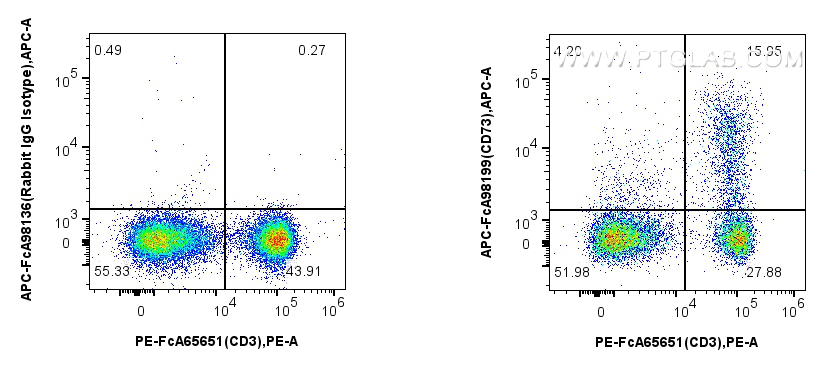验证数据展示
经过测试的应用
| Positive FC detected in | mouse splenocytes |
推荐稀释比
| 应用 | 推荐稀释比 |
|---|---|
| Flow Cytometry (FC) | FC : 0.1 ug per 10^6 cells in a 100 µl suspension |
| This reagent has been tested for flow cytometric analysis. It is recommended that this reagent should be titrated in each testing system to obtain optimal results. | |
| Sample-dependent, Check data in validation data gallery. | |
产品信息
APC-FcA98199 targets CD73 in FC applications and shows reactivity with mouse samples.
| 经测试应用 | FC Application Description |
| 经测试反应性 | mouse |
| 免疫原 | CD73 fusion protein Eg1389 种属同源性预测 |
| 宿主/亚型 | Rabbit / IgG |
| 抗体类别 | Recombinant |
| 产品类型 | Antibody |
| 全称 | 5' nucleotidase, ecto |
| 别名 | 5'-deoxynucleotidase, 5'-NT, 5'-nucleotidase, EC:3.1.3.99, Ecto-5'-nucleotidase |
| 计算分子量 | 64kDa |
| GenBank蛋白编号 | NM_011851.4 |
| 基因名称 | Nt5e |
| Gene ID (NCBI) | 23959 |
| 偶联类型 | APC Fluorescent Dye |
| 最大激发/发射波长 | 650 nm / 660 nm |
| 形式 | Liquid |
| 纯化方式 | Protein A purification |
| 储存缓冲液 | PBS with 0.09% sodium azide and 0.5% BSA, pH 7.3. |
| 储存条件 | Store at 2-8°C. Avoid exposure to light. Stable for one year after shipment. |
背景介绍
CD73 is a membrane-bound enzyme that catalyzes the extracellular hydrolysis of adenosine monophosphate (AMP) to produce adenosine. It is expressed on various immune cells, including T cells, B cells, dendritic cells, and regulatory T cells (Tregs). CD73 works in conjunction with CD39 to break down extracellular ATP into adenosine, creating an immunosuppressive environment that can inhibit the function of cytotoxic T cells and natural killer (NK) cells. This process is essential for immune tolerance and the resolution of inflammation. CD73 is also an important player in controlling tumor progression.
实验方案
| Product Specific Protocols | |
|---|---|
| FC protocol for APC CD73 antibody APC-FcA98199 | Download protocol |
| Standard Protocols | |
|---|---|
| Click here to view our Standard Protocols |
